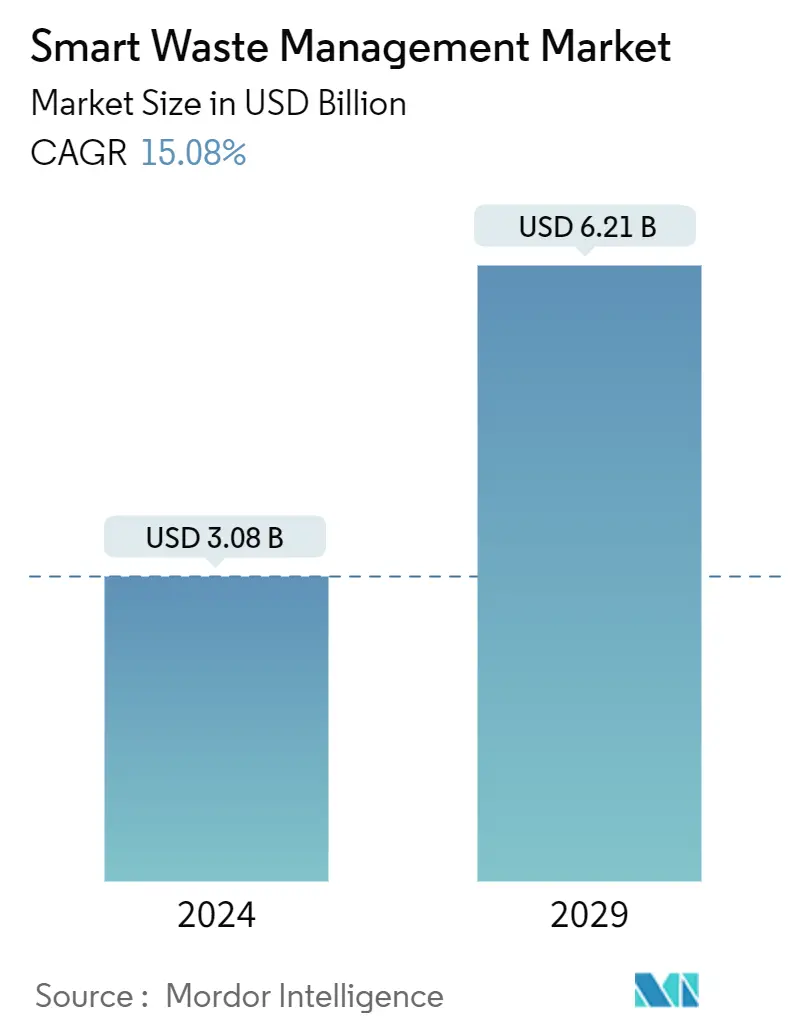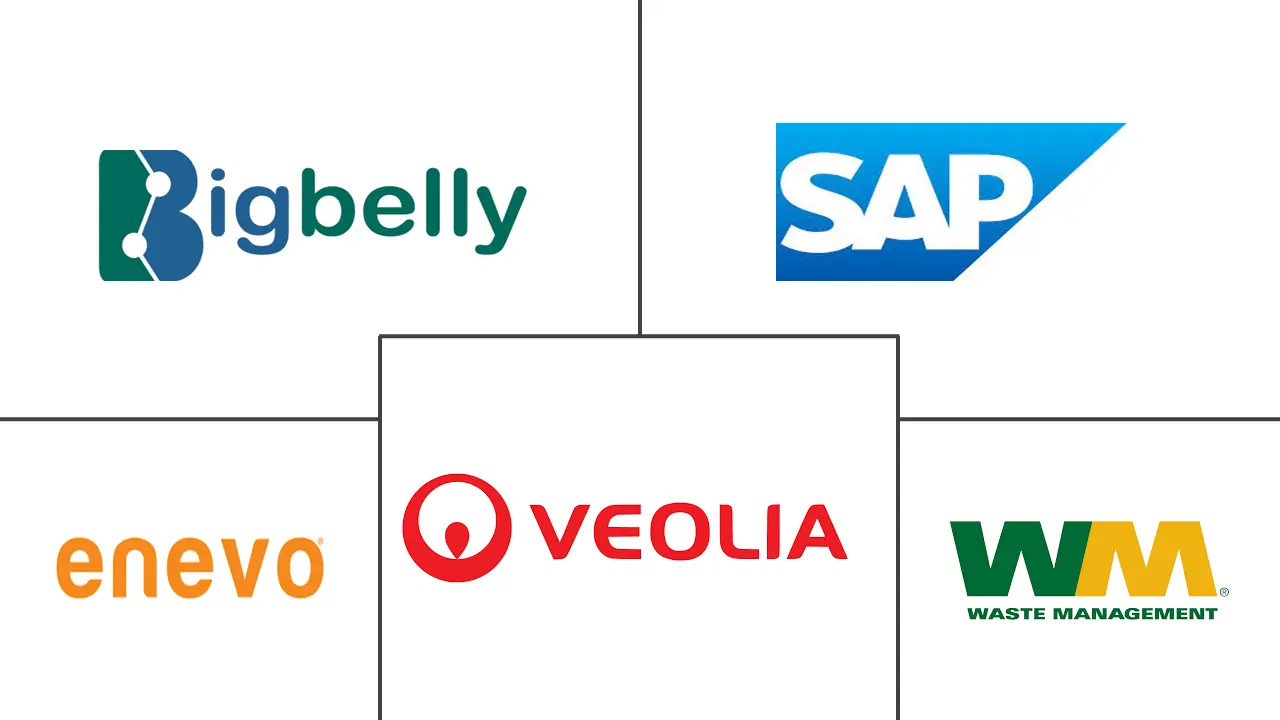Market Size of Smart Waste Management Industry

| Study Period | 2019 - 2029 |
| Market Size (2024) | USD 3.08 Billion |
| Market Size (2029) | USD 6.21 Billion |
| CAGR (2024 - 2029) | 15.08 % |
| Fastest Growing Market | Asia Pacific |
| Largest Market | North America |
Major Players
*Disclaimer: Major Players sorted in no particular order |
Smart Waste Management Market Analysis
The Smart Waste Management Market size is estimated at USD 3.08 billion in 2024, and is expected to reach USD 6.21 billion by 2029, growing at a CAGR of 15.08% during the forecast period (2024-2029).
Smart waste management directs the use of sensors in waste to observe the real-time status of municipal waste collection services and decide when bins should be emptied or filled. It also maintains track of past information collected by sensors and databases that can be utilized to pinpoint and enhance driver routes, fill patterns, and lower operating costs. Effective waste collection is more functional with remote monitoring and IoT-based waste bins. Urbanization and rapid industrialization are the two main drivers of the smart waste management market. Therefore, the volume of waste from the municipal and industrial sectors has grown. The routine collection and disposal of waste have risen due to rising environmental awareness.
- Smart waste management is crucial in developing smart cities (along with water management, traffic management, energy management, etc.) to improve lifestyles in urban areas. The increasing adoption of innovative city initiatives across regions helps the smart waste management market’s growth. The waste management industry involves diverse activities, such as collection, disposal, transportation, and recycling. The industry has been facing efficiency problems at different stages of waste management. The operational costs equal the collection and transport of the waste, thereby increasing the adoption of smart waste management.
- In recent years, owing to the growing population and urbanization, the global demand for waste management and the demand to address the cost implications of maintaining an aging infrastructure have been among the primary motivating factors for the smart waste management market’s growth.
- Moreover, the development of the smart waste management market has been assisted by products like disposable tags, containers, and vacuum cleaners that contain real-time waste management systems. The rising usage of waste management systems also results from growing environmental concerns.
- However, the lack of skilled laborers worldwide is expected to increase maintenance costs as most of them have to travel down to the service areas and resolve issues. Nevertheless, the growing focus on remote management may reduce the cost burden during the forecast period.
Smart Waste Management Industry Segmentation
The process of implementing a technique used to monitor the collection, disposal, and transportation of waste material services for efficient waste management operations is known as smart waste management. This relates to the Internet of Things (IoT), which includes numerous cameras, portable computers, and other devices.
The smart waste management market is segmented by solution (fleet management, remote monitoring, analytics), waste type (industrial waste, residential waste), and geography (North America (United States, Canada), Europe (Germany, United Kingdom, France, Italy, Spain, and Rest of Europe), Asia Pacific (India, China, Japan, Australia, and Rest of Asia-Pacific), and Rest of the World). The market size and forecasts are provided in terms of value (USD) for all the above segments.
| By Solution | |
| Fleet Management | |
| Remote Monitoring | |
| Analytics |
| By Waste Type | |
| Industrial Waste | |
| Residential Waste |
| By Geography | |||||||
| |||||||
| |||||||
| |||||||
| Latin America | |||||||
| Middle East and Africa |
Smart Waste Management Market Size Summary
The smart waste management market is poised for significant growth, driven by the increasing need for efficient waste collection and disposal solutions in the face of rapid urbanization and industrialization. This market leverages advanced technologies such as IoT and sensors to optimize waste management processes, including real-time monitoring of waste bins and route optimization for collection vehicles. The integration of these technologies not only enhances operational efficiency but also reduces costs associated with waste management. As cities worldwide strive to become smarter and more sustainable, the adoption of smart waste management systems is becoming increasingly prevalent, with urban areas in the United States and Canada leading the charge due to stringent environmental regulations and government initiatives aimed at reducing carbon emissions and promoting sustainability.
The market landscape is characterized by a fragmented industry with key players like SAP SE, Veolia Environmental Services, Enevo, Waste Management Inc., and Bigbelly Inc. actively competing to enhance their offerings. Recent developments, such as Veolia's contract in Hong Kong and WM's new recycling facility in Ohio, highlight the ongoing efforts to innovate and expand capabilities in waste management. Despite challenges such as the shortage of skilled labor, the focus on remote management and advanced fleet management solutions is expected to mitigate cost burdens. The market's growth is further supported by the increasing adoption of smart city initiatives and the rising demand for sustainable waste management practices, particularly in regions with high urban concentration and growing populations.
Smart Waste Management Market Size - Table of Contents
-
1. MARKET INSIGHTS
-
1.1 Market Overview
-
1.2 Industry Attractiveness - Porter's Five Forces Analysis
-
1.2.1 Bargaining Power of Suppliers
-
1.2.2 Bargaining Power of Buyers
-
1.2.3 Threat of New Entrants
-
1.2.4 Threat of Substitutes
-
1.2.5 Intensity of Competitive Rivalry
-
-
1.3 Impact of COVID-19 Aftereffects and Other Macroeconomic Factors on the Market
-
-
2. MARKET SEGMENTATION
-
2.1 By Solution
-
2.1.1 Fleet Management
-
2.1.2 Remote Monitoring
-
2.1.3 Analytics
-
-
2.2 By Waste Type
-
2.2.1 Industrial Waste
-
2.2.2 Residential Waste
-
-
2.3 By Geography
-
2.3.1 North America
-
2.3.1.1 United States
-
2.3.1.2 Canada
-
-
2.3.2 Europe
-
2.3.2.1 Germany
-
2.3.2.2 United Kingdom
-
2.3.2.3 France
-
2.3.2.4 Spain
-
2.3.2.5 Italy
-
-
2.3.3 Asia
-
2.3.3.1 India
-
2.3.3.2 China
-
2.3.3.3 Australia
-
2.3.3.4 Japan
-
2.3.3.5 Australia and New Zealand
-
-
2.3.4 Latin America
-
2.3.5 Middle East and Africa
-
-
Smart Waste Management Market Size FAQs
How big is the Smart Waste Management Market?
The Smart Waste Management Market size is expected to reach USD 3.08 billion in 2024 and grow at a CAGR of 15.08% to reach USD 6.21 billion by 2029.
What is the current Smart Waste Management Market size?
In 2024, the Smart Waste Management Market size is expected to reach USD 3.08 billion.

